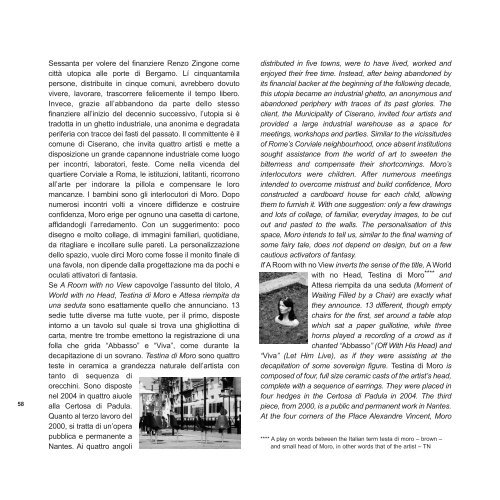Adachiara Zevi - arteinmemoria
Adachiara Zevi - arteinmemoria
Adachiara Zevi - arteinmemoria
Create successful ePaper yourself
Turn your PDF publications into a flip-book with our unique Google optimized e-Paper software.
58<br />
Sessanta per volere del finanziere Renzo Zingone come<br />
città utopica alle porte di Bergamo. Lí cinquantamila<br />
persone, distribuite in cinque comuni, avrebbero dovuto<br />
vivere, lavorare, trascorrere felicemente il tempo libero.<br />
Invece, grazie all’abbandono da parte dello stesso<br />
finanziere all’inizio del decennio successivo, l’utopia si è<br />
tradotta in un ghetto industriale, una anonima e degradata<br />
periferia con tracce dei fasti del passato. Il committente è il<br />
comune di Ciserano, che invita quattro artisti e mette a<br />
disposizione un grande capannone industriale come luogo<br />
per incontri, laboratori, feste. Come nella vicenda del<br />
quartiere Corviale a Roma, le istituzioni, latitanti, ricorrono<br />
all’arte per indorare la pillola e compensare le loro<br />
mancanze. I bambini sono gli interlocutori di Moro. Dopo<br />
numerosi incontri volti a vincere diffidenze e costruire<br />
confidenza, Moro erige per ognuno una casetta di cartone,<br />
affidandogli l’arredamento. Con un suggerimento: poco<br />
disegno e molto collage, di immagini familiari, quotidiane,<br />
da ritagliare e incollare sulle pareti. La personalizzazione<br />
dello spazio, vuole dirci Moro come fosse il monito finale di<br />
una favola, non dipende dalla progettazione ma da pochi e<br />
oculati attivatori di fantasia.<br />
Se A Room with no View capovolge l’assunto del titolo, A<br />
World with no Head, Testina di Moro e Attesa riempita da<br />
una seduta sono esattamente quello che annunciano. 13<br />
sedie tutte diverse ma tutte vuote, per il primo, disposte<br />
intorno a un tavolo sul quale si trova una ghigliottina di<br />
carta, mentre tre trombe emettono la registrazione di una<br />
folla che grida “Abbasso” e “Viva”, come durante la<br />
decapitazione di un sovrano. Testina di Moro sono quattro<br />
teste in ceramica a grandezza naturale dell’artista con<br />
tanto di sequenza di<br />
orecchini. Sono disposte<br />
nel 2004 in quattro aiuole<br />
alla Certosa di Padula.<br />
Quanto al terzo lavoro del<br />
2000, si tratta di un’opera<br />
pubblica e permanente a<br />
Nantes. Ai quattro angoli<br />
distributed in five towns, were to have lived, worked and<br />
enjoyed their free time. Instead, after being abandoned by<br />
its financial backer at the beginning of the following decade,<br />
this utopia became an industrial ghetto, an anonymous and<br />
abandoned periphery with traces of its past glories. The<br />
client, the Municipality of Ciserano, invited four artists and<br />
provided a large industrial warehouse as a space for<br />
meetings, workshops and parties. Similar to the vicissitudes<br />
of Rome’s Corviale neighbourhood, once absent institutions<br />
sought assistance from the world of art to sweeten the<br />
bitterness and compensate their shortcomings. Moro’s<br />
interlocutors were children. After numerous meetings<br />
intended to overcome mistrust and build confidence, Moro<br />
constructed a cardboard house for each child, allowing<br />
them to furnish it. With one suggestion: only a few drawings<br />
and lots of collage, of familiar, everyday images, to be cut<br />
out and pasted to the walls. The personalisation of this<br />
space, Moro intends to tell us, similar to the final warning of<br />
some fairy tale, does not depend on design, but on a few<br />
cautious activators of fantasy.<br />
If A Room with no View inverts the sense of the title, A World<br />
with no Head, Testina di Moro **** and<br />
Attesa riempita da una seduta (Moment of<br />
Waiting Filled by a Chair) are exactly what<br />
they announce. 13 different, though empty<br />
chairs for the first, set around a table atop<br />
which sat a paper guillotine, while three<br />
horns played a recording of a crowd as it<br />
chanted “Abbasso” (Off With His Head) and<br />
“Viva” (Let Him Live), as if they were assisting at the<br />
decapitation of some sovereign figure. Testina di Moro is<br />
composed of four, full size ceramic casts of the artist’s head,<br />
complete with a sequence of earrings. They were placed in<br />
four hedges in the Certosa di Padula in 2004. The third<br />
piece, from 2000, is a public and permanent work in Nantes.<br />
At the four corners of the Place Alexandre Vincent, Moro<br />
**** A play on words between the Italian term testa di moro – brown –<br />
and small head of Moro, in other words that of the artist – TN


